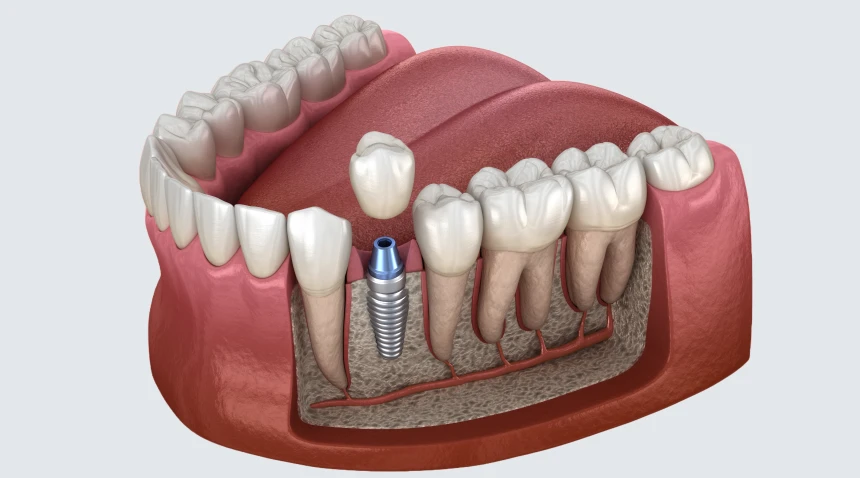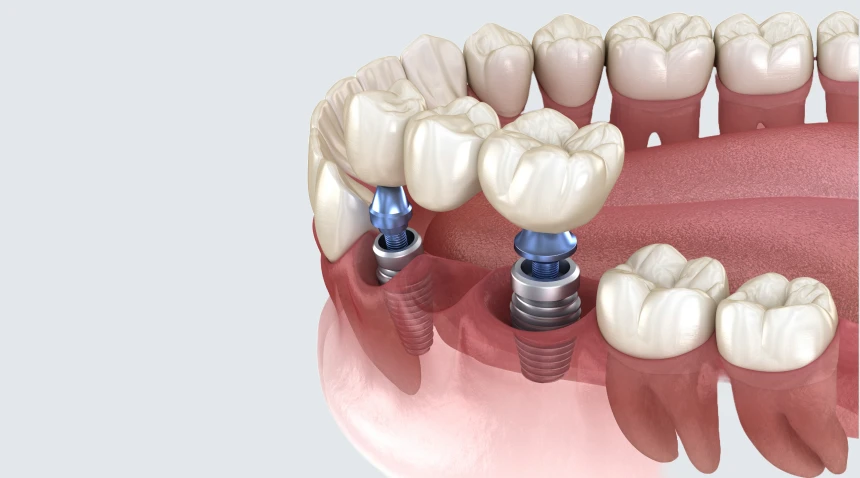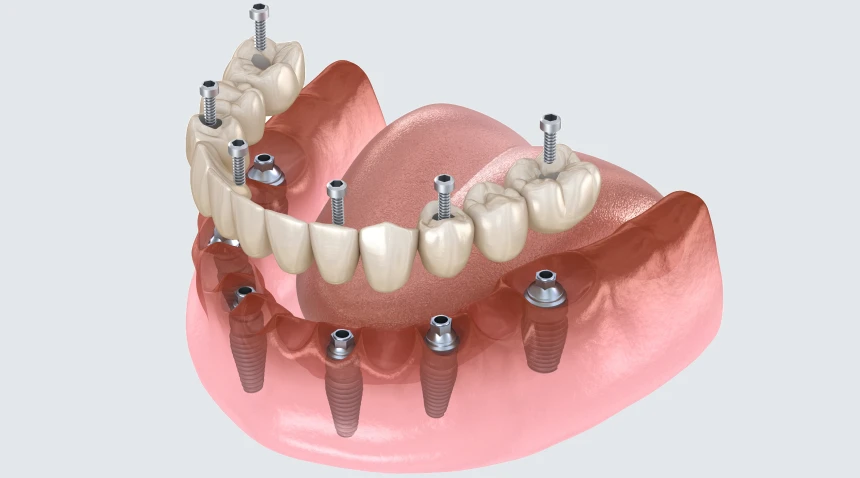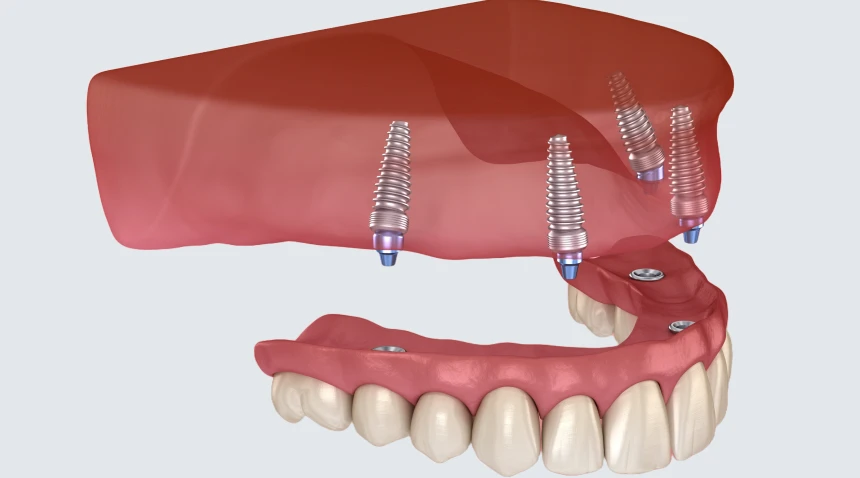An implant-supported prosthesis is a dental restoration designed to replace one or several missing teeth. It is supported by one or more dental implants, which are inserted directly into the jawbone to provide a stable foundation for an artificial tooth. Unlike removable dentures, this option offers a fixed solution that significantly improves everyday comfort.
Depending on the number of teeth to be replaced, the restoration may take the form of a crown, a bridge, or a full prosthesis. This treatment restores both chewing function and aesthetics while preserving the surrounding bone structures.

The different types of implant-supported prostheses
The dentist can attach various types of prostheses to implants, depending on the number of teeth to be replaced and the patient’s clinical situation.
- Single crown on implant:
Used when a single tooth is missing. The implant replaces the tooth root and supports a ceramic crown that replicates the natural tooth in both function and appearance. - Bridge on implants:
This option replaces several missing teeth. Two or more implants are placed to support an intermediate structure consisting of multiple artificial teeth, without requiring an implant for each tooth. - Fixed full prosthesis:
Recommended for fully edentulous patients. Several implants are placed to support a fixed prosthesis that remains permanently in place. - Removable prosthesis stabilized by implants:
This solution combines the stability of implants with the flexibility of a removable denture. It clips onto specific attachments secured to the implants, providing greater comfort and retention than a conventional removable prosthesis.
This variety of solutions allows treatment to be tailored to each patient’s needs, taking into account anatomical constraints, aesthetic expectations, and desired comfort.




Treatment steps
Treatment with an implant-supported prosthesis follows a precise sequence based on strict clinical protocols. It usually takes place over several months to ensure implant stability and the quality of the final restoration.
- Clinical and radiological assessment
The first step is to examine the patient’s oral condition. This includes a full assessment with panoramic X-rays or a 3D scan to check the quantity and quality of the available bone and to identify any possible contraindications. - Placement of the implants
The implants are surgically inserted into the jawbone under local anesthesia. This is followed by a healing period known as osseointegration, during which the implant gradually fuses with the bone. This process generally takes between two and six months, depending on the individual case. - Fabrication of the prosthesis
Once successful integration of the implants has been confirmed, impressions are taken to create a custom-made prosthesis. It is then securely attached to the implants and adjusted to fit the patient’s anatomy.
This step-by-step process ensures a controlled and gradual restoration, with careful monitoring throughout each stage of the treatment.
Follow-up and maintenance

Although implant-supported prostheses are designed to be long-lasting, their durability depends directly on daily care. Patients should brush their teeth meticulously, use interdental brushes or specialized dental floss, and maintain regular follow-up visits at the clinic.
An annual check-up is recommended to perform both a clinical and radiological evaluation. This appointment allows the dentist to assess the condition of the implants, the prosthesis, and the surrounding tissues.
Who can benefit from this treatment?
An implant-supported prosthesis can be suitable for many patients. It is intended for those who have lost one or several teeth and wish to regain lasting comfort. However, certain conditions must be met: good oral hygiene, sufficient bone volume, and the absence of uncontrolled medical conditions such as poorly managed diabetes or severe periodontal disease.
The dentist begins with a complete medical and dental assessment to determine the patient’s eligibility. If the bone volume is insufficient, bone grafting or a sinus lift may be recommended before implant placement. The treatment is then personalized to meet each patient’s specific anatomical needs.
Are there any risks or complications?
As with any surgical procedure, some risks exist. These may include infection, postoperative discomfort, or, more rarely, implant failure due to lack of osseointegration. However, when the patient follows hygiene recommendations and postoperative instructions carefully, success rates remain very high.
It is also important to stop smoking before implant placement. Smoking is a major risk factor because it impairs bone healing and increases the likelihood of inflammation around the implant.
Impact on quality of life
An implant-supported prosthesis significantly enhances daily comfort. By restoring proper chewing function, it improves digestion and nutritional balance. It also allows for easier and more natural speech, without the discomfort or instability associated with removable dentures. Aesthetically, it provides a natural appearance thanks to the accurate reproduction of tooth shape and color.
By restoring self-confidence and providing long-term stability, this treatment has a profoundly positive impact on the patient’s overall well-being. It also helps prevent bone resorption, which commonly occurs after tooth extraction, and preserves facial volume over time. Moreover, it supports harmonious aging by maintaining both the functional and aesthetic balance of the mouth.
It is therefore a reliable and long-lasting solution for regaining a natural and confident smile.

FAQ — Implant-Supported Prosthesis
- Is the procedure painful?
The implant is placed under local anesthesia. Postoperative discomfort may occur, but it is usually mild and well managed with prescribed pain relief. - How long does the treatment take?
The duration varies from case to case, but on average, the full process takes between 3 and 9 months from start to finish. - Can an implant-supported prosthesis be placed at any age?
There is no strict age limit. However, the procedure is only performed once bone growth is complete, which excludes children and adolescents. A thorough medical assessment is always carried out for older patients. - Is the prosthesis reimbursed?
The French national health insurance partially covers certain procedures. Clear and personalized estimates are provided to help patients understand any remaining costs. - How long does an implant last?
With proper hygiene and regular follow-up visits, an implant can last for several decades.
Book an Appointment in Paris 16
The Cabinet dentaire Mirabeau welcomes patients wishing to consider an implant-supported prosthesis in a calm and comfortable setting. An initial consultation allows for a full assessment of your situation and the selection of the most suitable treatment option.
Book your appointment online to speak with a dentist and receive personalized care and guidance.
You may also like: Dental implant placement